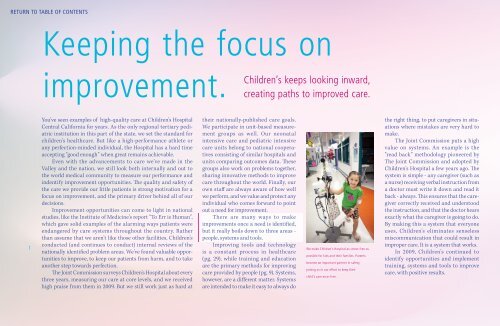Wellness, revolutionized. - Children's Hospital Central California
Wellness, revolutionized. - Children's Hospital Central California
Wellness, revolutionized. - Children's Hospital Central California
You also want an ePaper? Increase the reach of your titles
YUMPU automatically turns print PDFs into web optimized ePapers that Google loves.
RETURN TO TABLE OF CONTENTS<br />
1<br />
Keeping the focus on<br />
improvement.<br />
You’ve seen examples of high-quality care at Children’s <strong>Hospital</strong><br />
<strong>Central</strong> <strong>California</strong> for years. As the only regional tertiary pediatric<br />
institution in this part of the state, we set the standard for<br />
children’s healthcare. But like a high-performance athlete or<br />
any perfection-minded individual, the <strong>Hospital</strong> has a hard time<br />
accepting “good enough” when great remains achievable.<br />
Even with the advancements to care we’ve made in the<br />
Valley and the nation, we still look both internally and out to<br />
the world medical community to measure our performance and<br />
indentify improvement opportunities. The quality and safety of<br />
the care we provide our little patients is strong motivation for a<br />
focus on improvement, and the primary driver behind all of our<br />
decisions.<br />
Improvement opportunities can come to light in national<br />
studies, like the Institute of Medicine’s report “To Err is Human”,<br />
which gave solid examples of the alarming ways patients were<br />
endangered by care systems throughout the country. Rather<br />
than assume that we aren’t like those other facilities, Children’s<br />
conducted (and continues to conduct) internal reviews of the<br />
nationally identified problem areas. We’ve found valuable opportunities<br />
to improve, to keep our patients from harm, and to take<br />
another step towards perfection.<br />
The Joint Commission surveys Children’s <strong>Hospital</strong> about every<br />
three years, measuring our care at core levels, and we received<br />
high praise from them in 2009. But we still work just as hard at<br />
Children’s keeps looking inward,<br />
creating paths to improved care.<br />
their nationally-published care goals.<br />
We participate in unit-based measurement<br />
groups as well. Our neonatal<br />
intensive care and pediatric intensive<br />
care units belong to national cooperatives<br />
consisting of similar hospitals and<br />
units comparing outcomes data. These<br />
groups also work on problems together,<br />
sharing innovative methods to improve<br />
care throughout the world. Finally, our<br />
own staff are always aware of how well<br />
we perform, and we value and protect any<br />
individual who comes forward to point<br />
out a need for improvement.<br />
There are many ways to make<br />
improvements once a need is identified,<br />
but it really boils down to three areas -<br />
people, systems and tools.<br />
Improving tools and technology<br />
is a constant process in healthcare<br />
(pg. 29), while training and education<br />
are the primary methods for improving<br />
care provided by people (pg. 9). Systems,<br />
however, are a different matter. Systems<br />
are intended to make it easy to always do<br />
We make Children’s <strong>Hospital</strong> as stress-free as<br />
possible for kids and their families. Parents<br />
become an important partner in safety,<br />
joining us in our effort to keep their<br />
child’s care error-free.<br />
the right thing, to put caregivers in situations<br />
where mistakes are very hard to<br />
make.<br />
The Joint Commission puts a high<br />
value on systems. An example is the<br />
“read back” methodology pioneered by<br />
The Joint Commission and adopted by<br />
Children’s <strong>Hospital</strong> a few years ago. The<br />
system is simple - any caregiver (such as<br />
a nurse) receiving verbal instruction from<br />
a doctor must write it down and read it<br />
back - always. This ensures that the caregiver<br />
correctly received and understood<br />
the instruction, and that the doctor hears<br />
exactly what the caregiver is going to do.<br />
By making this a system that everyone<br />
uses, Children’s eliminates senseless<br />
miscommunication that could result in<br />
improper care. It is a system that works.<br />
In 2009, Children’s continued to<br />
identify opportunities and implement<br />
training, systems and tools to improve<br />
care, with positive results.


